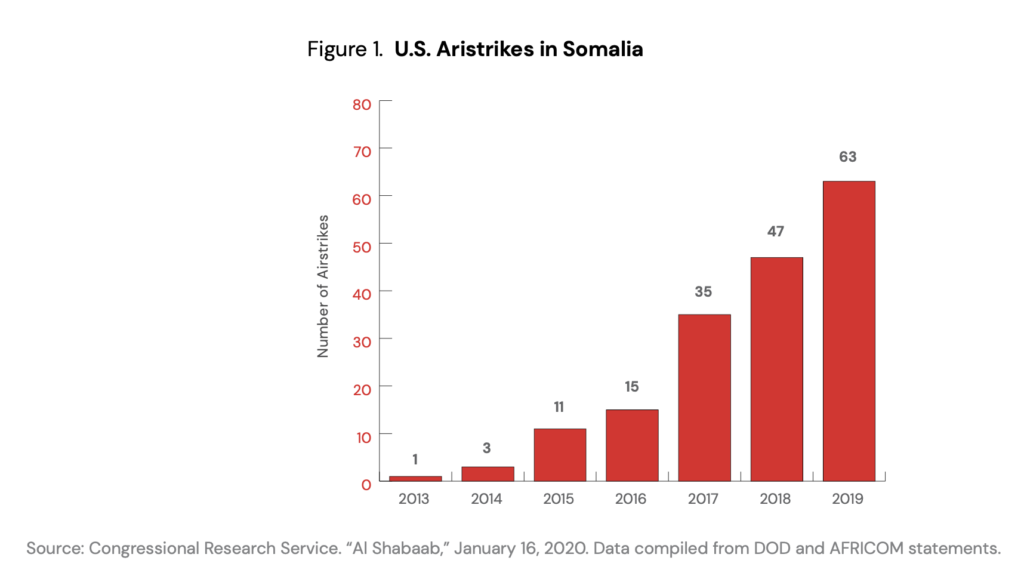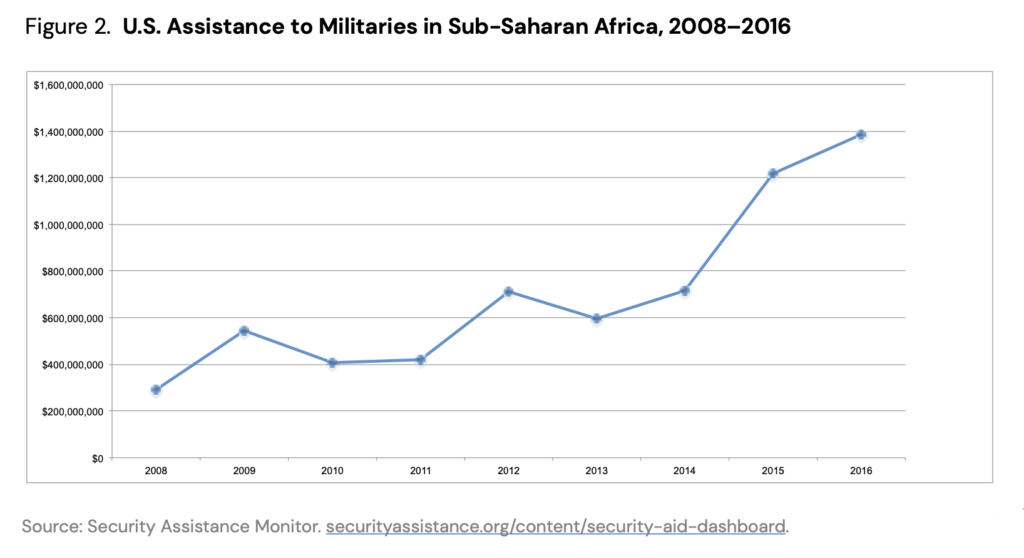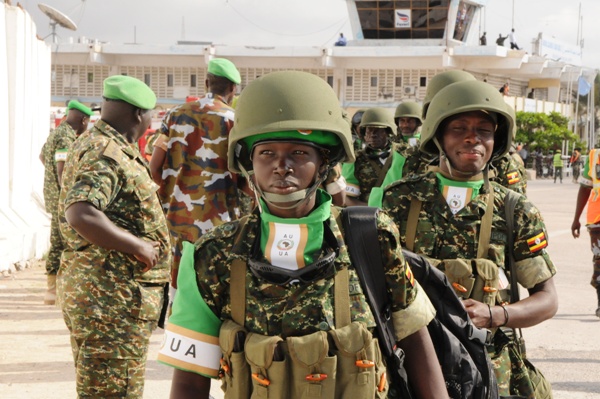Executive Summary
In U.S. foreign policy circles today, the bar to justify ending a military intervention is higher than it is to keep one going. Small wars have become routine foreign policy tools, executed with minimal oversight or scrutiny. Somalia offers a clear example of how this approach leads to high accumulated costs for the American people with little to show in gains for the U.S. national interest. The current military-led strategy promises no end to lethal interventions, and the costs and risks associated with it exceed the threats it is meant to address. Expanding U.S. military activity over the past five years has done little to impede the Somali terrorist insurgency group al–Shabaab, but it has continued to overshadow and undermine diplomatic and development efforts to address Somalia’s political and governance problems. At the same time, military intervention has propped up an ineffective government, disincentivizing Somali political leaders from taking the hard steps necessary to reach a sustainable peace and build a functioning state.
The U.S. military cannot be expected to stay indefinitely in Somalia to maintain a messy stalemate. Rather than reflexively increase U.S. military activity when it falls short of stated objectives, the United States should reassess its overall strategy in Somalia by returning to basic questions: Why is the U.S. military fighting a war there? What U.S. national interest is the war serving? And are America’s actions in Somalia and the region furthering that national interest?
‘Today, the bar to justify ending a military intervention is higher than it is to keep one going.’
Some U.S. national interests in Somalia are clear: preventing attacks on Americans and American property — U.S. embassies, citizens, and, of course, the homeland — and, to a measured extent, preventing attacks on U.S. partners in the region, based on common interests. Somalia also sits on the Gulf of Aden, a strategic waterway critical to international trade. Protecting the safe transit of commercial ships through the gulf and the Indian Ocean is valuable for the U.S. and global economies alike. Beyond those core goals, however, U.S. interests in Somalia are less evident. For example, is it in the U.S. national interest to have a functioning, uncorrupted, and inclusive government in Somalia, led by a credible central authority? Generally, yes, to the extent that this has implications for stability and strategic American interests in East Africa and the broader region. A stable and democratic Somali state, however, is not inherently essential to U.S. national security, so that interest must be balanced with the associated cost, risk, and the impact of the intervention which may work against that goal.
America’s long-running but largely hidden war against al–Shabaab has been justified as necessary to prevent attacks on Americans and American interests, but the military operations are not commensurate with the actual risk al–Shabaab poses to America. Like U.S. efforts in Afghanistan, what began as an effort to track and target those connected to or planning direct attacks on U.S. interests expanded into a broad state-building effort to prop up a preferred government. Not only does it exceed the scope of that risk today, but U.S. military activity in Somalia also appears to be the driving force behind the threat al–Shabaab poses to Americans in the region. This raises the question of whether U.S. interests are served at all by a military intervention that puts U.S. forces in harm’s way and has cost billions of dollars.
Diplomatic and development interventions are far less costly and less likely to risk aggravating or expanding violent conflict, including actions against the United States. Reducing and ultimately ending U.S. military engagement, while reorienting around civilian capacities and enhancing its investment in diplomatic and development interventions would better align the costs and risks of U.S. intervention with its national security interests. This approach would not guarantee the facilitation of a functioning and democratic Somali state, but the military-led strategy has already proven unable to secure the same. Such an outcome might be attractive, but it is not essential to U.S. national security interests in the region, and guaranteeing it is beyond the capacity of the United States. Accordingly, the United States needs to launch a new civilian-led strategy in Somalia that aligns the investment, cost, and risk of the intervention to the national interests involved.
Critics of this approach will argue that stepping down U.S. military engagement could lead other military interventions to wind down, too—in particular the regional peacekeeping African Union Mission in Somalia (AMISOM) — and that this could open the door to a resurgence of al–Shabaab that could ultimately defeat the Federal Government of Somalia (FGS). Al–Shabaab is a bad actor, and the insurgency has caused significant public harm, including an estimated 3,000 civilian casualties from 2017 to 2019. But this fact alone is not enough to justify continuing U.S. participation in war activities against it, with the accompanying cost and risks to American interests, as well as the risk that the use of lethal force by the United States could be compounding the conflict further by aggravating local grievances and propping up an ineffective government rife with corruption.
The U.S. government should reorient its intervention in Somalia, leading with diplomacy and development endeavors targeted at political and governance challenges, while reducing and eventually ending military engagement. Congress and the American people should insist on a clear articulation of U.S. interests in Somalia, and interventions should be designed specifically to promote and achieve them. Key recommendations include:
• End the military intervention as responsibly as possible, over a period of approximately five years, and shift the focus of engagement to encouraging better governance.
• Prioritize the resolution of ongoing tensions and the conflict between the central government and the administrations of the five Federal Member States, by intensifying diplomacy, by pursuing milestones and metrics for progress toward a more stable state, and by including improved service delivery, inclusion, and development goals.
• Empower and fund diplomacy adequately to meet the challenge.
• Prior to ending the military intervention, leverage targeted military assistance to promote and incentivize progress on these political and governance priorities.
• Dramatically increase congressional oversight of U.S. counterterrorism strategy—including deployments of Special Operations Forces (SOF), foreign military training, and drone strikes.
A rebalance of U.S. focus and resources in Somalia could provide a playbook for winding down other U.S. counterterrorism missions that have similarly reached a counterproductive impasse. The aim should be aligning investment, costs, and risks with clear and articulated U.S. national interests and reducing to a minimum the potential negative externalities that military action often incurs. This shift need not result in retrenchment of America’s influence on the world stage. Indeed, enhancing the capacity and authority of civilians to lead in fragile states increases the potential for U.S. influence to be positive, or at least neutral, rather than unintentionally destabilizing at an even higher cost.
Introduction: U.S. Counterterrorism in Africa
On October 4, 2017, four U.S. Army Special Forces soldiers were killed in an ambush during a training mission with Nigerien soldiers along Niger’s border with Mali. At the Pentagon, the incident raised questions. How did such a routine mission turn deadly? How was the threat assessment so wrong? Why did the chain of command approve the mission? Outside the Pentagon, the question was more basic. What were U.S. soldiers doing there in the first place? A similar question could well have been asked in January 2020, when an al–Shabaab attack on Camp Simba, near the Somali border in Kenya, killed one U.S. service member and two Defense Department contractors. The pertinent question was not asked on this occasion. Instead, within days, the U.S. Africa Command’s East African Response Force deployed reinforcements, and in September 2020, The New York Times reported that AFRICOM was seeking authorization to expand its drone strike operation into Kenya.
U.S. intelligence services were tracking Osama bin Laden in Sudan in the 1990s, well before al–Qaeda gained infamy in 1998 with the bombings of the U.S. embassies in Nairobi and Dar es Salaam. Only after the September 11 attacks, however, did U.S. counterterrorism efforts in Africa assume a permanent footprint. In 2002, the George W. Bush administration established the Combined Joint Task Force–Horn of Africa in Djibouti. In 2003, the administration announced a $100 million counterterrorism initiative in East Africa and the Horn. By 2007, the U.S. military’s focus on Africa was substantial enough to merit a dedicated combatant command: AFRICOM. Under President Obama, the counterterrorism focus in Africa continued to grow, further drowning out development and diplomacy initiatives. The Obama administration increased drone strikes in Somalia fourfold over the Bush administration; it also dramatically expanded military arms sales and training across the continent. The precision approach and arms-length nature helped the growing wars in Africa largely escape congressional oversight and public scrutiny.

U.S. military activities in Africa have grown under the Trump administration, and civilian oversight has declined even further. In March 2017, the White House expanded targeting authority in Somalia to allow the military to conduct strikes with less vetting and less-restrictive battlefield rules, which led to an unprecedented increase in targeted killings. The administration quadrupled the number of strikes in Somalia in less than a single term. Today, the U.S. military has 29 bases and approximately 6,000 Department of Defense personnel across Africa, not including an additional 2,000 personnel staffing AFRICOM in Stuttgart, Germany, and elsewhere, in what the Pentagon describes as a light footprint and low-cost endeavor.
Notably, by December 2019 the Pentagon had begun to question the utility of these initiatives. But rather than welcoming an effort by Secretary of Defense Mark Esper to assess the purpose and efficacy of U.S. military action across the continent, Congress defended it on a bipartisan basis. This response reflected a view by lawmakers that the only option for meaningful engagement with the African continent, given the United States’ chronic underfunding and dismissal of diplomatic alternatives, is military engagement.
As the wars in Afghanistan and Iraq became less tenable, the military turned to smaller operations, executed primarily by Special Operations Forces with maximum flexibility and minimal bureaucratic impediment. SOF engagements in Africa, as elsewhere, are highly classified. They include support for foreign and irregular forces, over which the United States has little control, as well as direct actions such as airstrikes. Their activities escape the layers of oversight that Congress requires of all other assistance programs — from annual monitoring and evaluation reporting to intensive approval processes and public disclosures — thus severely hindering efforts to impose accountability.
With inadequate scrutiny, these interventions grew not only in number but also in their objectives. What began as efforts to target America’s enemies became complex programs to fortify friends and transform societies — without strategies that could realistically achieve the latter goal. Conventional wisdom suggested that building up partner security forces through training, weapons, and other supplies would naturally enhance stability. When partner forces continually fell short of target standards, U.S. policymakers relabeled the security assistance as an exercise in maintaining influence and favor, a boon to the great-power competition that has recently heated up in Africa. Increasingly, the purpose was shaped to meet the activity rather than the other way around. With such amorphous goals, assessing the utility of these interventions would be difficult even if they had been transparent.

By 2019, SOF were deployed in 141 countries worldwide, up from 60 a decade earlier. These missions grow but rarely wind down. Their success is measured in military metrics — terrorist targets killed and partner military personnel trained or equipped — rather than in metrics aligned with a clear national security interest or with the decrease in terrorism these missions are allegedly aiding. The vast majority of the insurgency groups targeted by U.S. activity in Africa, of which there are now more than two dozen, pose no threat to the American homeland or to American citizens, other than the U.S. service members or contractors sent to fight them. Indeed, it is now the American military presence that heightens the risk that these insurgent groups will turn their sights on U.S. targets.
This situation raises questions that Americans, and Congress specifically, should have been asking long ago: What is the purpose of these missions today? What are U.S. forces trying to achieve, and what does it take to achieve it? Rather than fight the Pentagon’s plan to finally assess counterterrorism programming in Africa, as it has done to date, Congress should demand the purpose and endgame be clearly stated and should welcome the end of these interventions rather than fear it
Before it’s here, it’s on Quincy Institute For Responsible Statecraft
Statements, comments or opinions published in this column are of those of the author(s) and do not necessarily reflect the editorial policy of Warsan magazine. Warsan reserves the right to moderate, publish or delete a post without prior consultation with the author(s). To publish your article or your advertisement contact our editorial team at: warsan54@gmail.com

